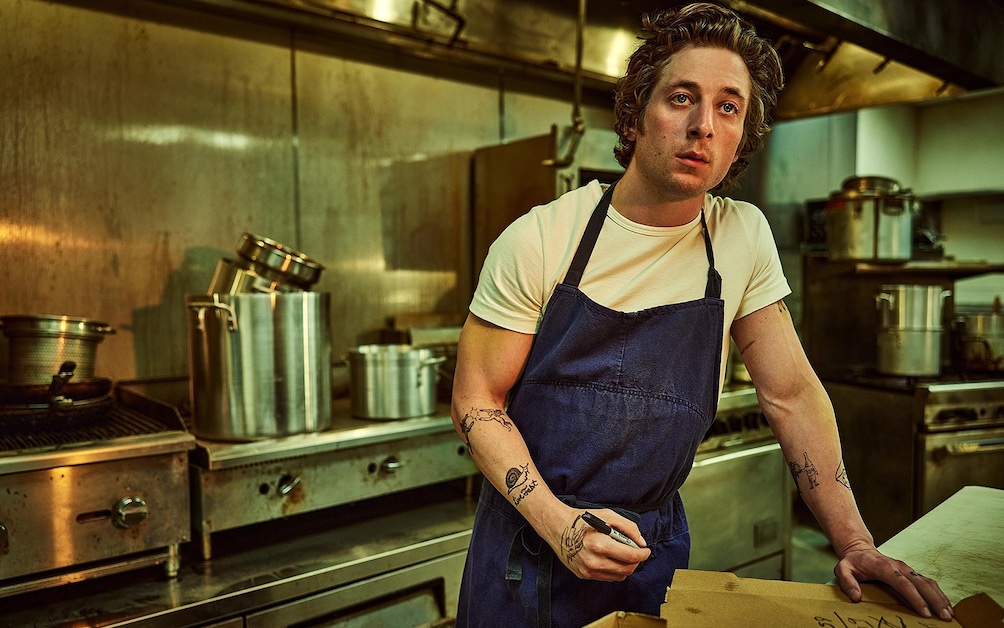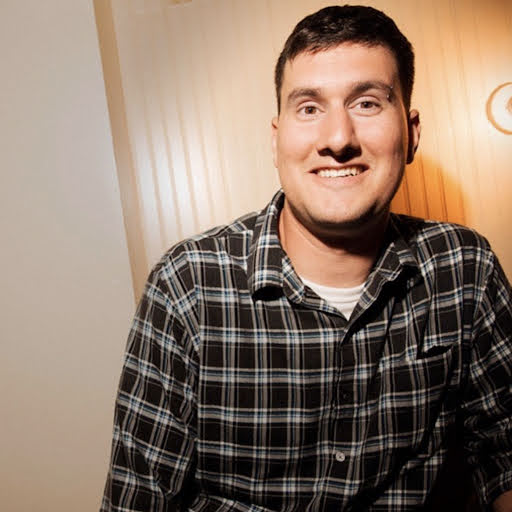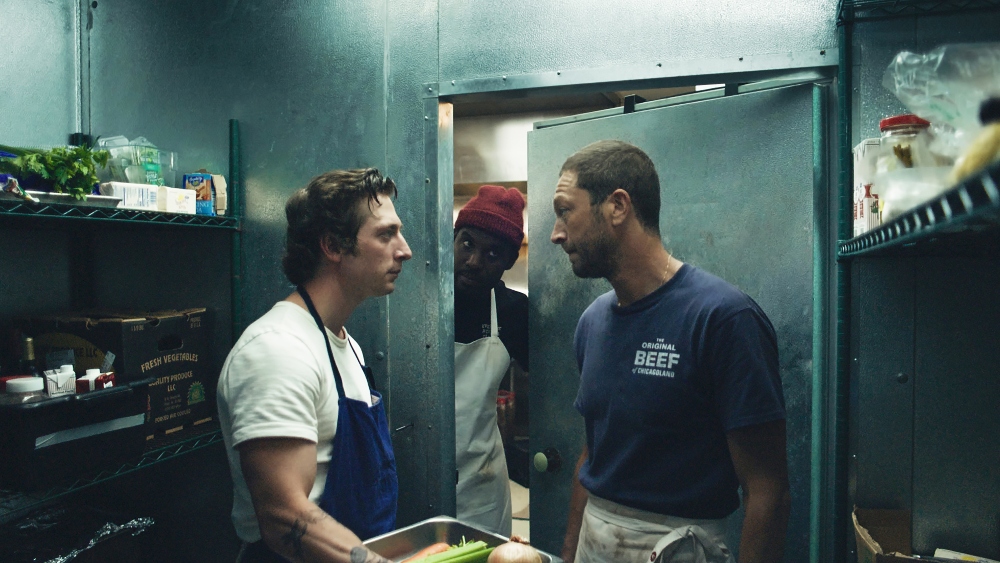
Steve “Major” Giammaria is good at multitasking. Just in the past year, the veteran Supervising Sound Editor and Re-Recording Mixer has worked his magic on The Bear (seasons one and two), The Crowded Room, Theater Camp, and Sesame Street. He won a MPSE Golden Reel Award for The Bear and is up for not one, but two, Emmys for his work on season one of The Bear. He’s nominated for Outstanding Sound Mixing For A Comedy Or Drama Series (Half-Hour) And Animation and Outstanding Sound Editing For A Comedy Or Drama Series (Half-Hour) And Animation.
Giammaria’s career dates back more than 15 years and includes MacGruber, The Hunger Games, Ramy, and American Rust. Below the Line recently caught up with Giammaria via Zoom from his office at Manhattan’s Sound Lounge for a detailed conversation about The Bear, juggling multiple gigs at once, the evolution of sound recording, and more.

Below the Line: What’s it like to be double-nominated?
Steve Giammaria: It was a surprise and an honor, for sure. I feel like more shows now are combining the Supervising Sound Editor and Re-recording Mixers, and especially on smaller shows – half-hours — I see that a lot more these days. It has to do with the blurring of the lines of editorial versus mixing a little bit. Also, the more fluid process of finishing. You’re not saying, “Okay, Episode 1 is done. Let’s move on to Episode 2 and Episode 3.” All the episodes drop at once. They’re all open until very close to the end, so you can be making changes on 1 when you’re finishing 9. Having that person be the same person when applicable is helpful, not having the re-recording mixer being a hired gun for the last two days of a show or something. It was certainly a surprise and an honor, for sure.
BTL: Well, congratulations. Let’s go back a step. Which came first, your love of tech or your love of sound?
Giammaria: I feel like they both happened simultaneously. My dad was ahead of the curve when it came to computing in the 90s; we had dial-up internet before most people. I was always into tech stuff. I was a musician and never good enough to make it like that, so I thought, “Hey! Computers… music… let’s combine them and go to school for recording.” That’s how that happened.
BTL: During your time in the industry, how would you say tech and sound have evolved? How have they evolved together?
Giammaria: That’s a great question. Technology allows you to do things quicker, and there’s a lower barrier to entry, for sure. When I started 15 years ago, a Pro Tools system cost tens of thousands of dollars. Now you can run it on a laptop and for $19.99 a month you can get the same tools that we use, which is good, but also now everybody can be a mixer or editor, which maybe they can’t or shouldn’t be. Technologically-wise, we’re going from stereo to 5.1 to Atmos; all of those things to help immerse the listener, which there’s debates as to whether those are even worth it or just parlor tricks. The two things definitely influence each other. You can get into some problems — over-reliant on tech — when it’s like, “Point a good microphone at a good source and it’s going to sound good.”
BTL: How did you connect with The Bear?
Giammaria: I had worked with Josh Senior, one of the Executive Producers, for a while on his other shows. I did a show called Ramy, which Chris Storer is a director on and, I believe, a producer. When The Bear pilot came through, I wasn’t able to do it because of a scheduling conflict. They came back to me for the series and we just went from there.
BTL: What were your marching orders on Season 1?
Giammaria: Loud and cacophonous. They wanted to feel the tension of the kitchen. There’s never a quiet moment in the kitchen. That was a huge thing. The tension and the stakes are very high, and everything is loud all the time. Always music, always multiple people talking and pots banging.
At one point, Chris Storer, the Showrunner, said, “I want people to want to turn this off.” At the time, I was like, “Come on,” but I came to realize what he meant. When you listen to some of these episodes, it’s like a panic attack. You’re like, “Oh my God, what is happening here?” You want to turn it off, but you don’t want to turn it off, because you need to see what happens next. He had a very clear vision, for sure, from the start.
BTL: To you, should sound be a character unto itself, or is it a complementary piece to the characters and what’s happening on the screen?
Giammaria: The answer is it depends. Obviously. In a show like this, where there are some highly stylized elements, it can shift into where it’s a character, but often I try not to do sound design for sound design’s sake. You need to zoom out. How are we serving the story? How are we serving the characters and the emotion of the scene? My Effects Editor said, “Look at this cool thing!” I’m like, “That’s great. I’m going to mute it, though, because this moment does not need it.” We all want our work to shine, but as the Re-recording Mixer, I’m the traffic cop at the end of the day, deciding how we are going to blend these two things together to achieve the emotion of the scene, to help tell the story. That’s what it’s all about.

BTL: Sound in many TV shows is awful. As in, we need to turn on closed captioning to understand the dialogue. What are your thoughts on the matter? We should be able to hear what people are saying, correct?
Giammaria: We should. The problem is… there are several problems. We — as Mixers — are beholden to the Showrunners and the creatives that hire us. So, if they want a cinematic mix from me, they will get that. The problem is a few things. It’s overly dynamic television, so if you have somebody that’s used to mixing in a theater — they’re finishing in a theater — it’s going to sound overly dynamic. The loud things are going to be too loud and the quiet things are going to be too quiet. When you put that on television, in your living room with not a controlled environment, you’re going to be changing the volume. It’s mixing in the improper environment, which sometimes you have to mix in a big room because 40 executives want to show up, so, “Hey, you’ve got to do it.” It’s planning from the stage and controlling the dynamic range. It’s making sure because you know the dialogue so well, that you weren’t under-mixing it. Like, “Oh, more music! It’s fine. We know what they’re saying.” It’s more like, “You know because you wrote it and you’ve heard it 1,400 times, but we need to make sure the audience who gets one crack at this can hear every word.” It’s all those things.
You have to take a conscious, planned approach to making sure you have great Dialogue Editors. My Dialogue Editor, Evan Benjamin… outstanding, great production sound. Scott D. Smith out of Chicago, he’s a veteran guy and knows what he’s doing. If he doesn’t do his job right, this show doesn’t happen. You can’t ADR nine people yelling over each other in a kitchen; it’s just not going to have the same intensity that it did on the day. You have to have good people starting from production. You have to capture it well, you have to edit it well, and then you have to mix it well with a dialogue-first mentality of, “I want to make sure everybody hears this.”
BTL: How often are you on set, if ever?
Giammaria: Surprisingly, I have never been on a film set in my life. So, there we go. Never.
BTL: Do you think that would help you in any way?
Giammaria: I don’t know. I would love to hang out with the production guys, and it’s just never happened. I’m not on a show until it’s wrapped — usually — unless it’s a second or third season of a show, in which case The Bear is in Chicago or I’m on some other projects. It just hasn’t happened.
I actually had some set visits planned and then COVID happened. There needs to be more communication between production and post, especially on films, because you don’t get a second season (on a film). I never meet some of these people or talk to them at all, because I’m on the project when they’re long gone. It is what it is.
BTL: Everyone still talks about the one-shot sequence [from season one, episode seven]. Please, take us through your end of helping pull it off.
Giammaria: That one, because it’s a oner, I’m able to do some things that I normally can’t. Normally dialogue’s straight up the middle, unless it’s a very rare occasion where somebody’s like, “Hey buddy!” from off-screen, then you can pan it. Normally, if it’s continued dialogue in a scene — because you’re changing cameras’ perspectives, you’re cutting one close-up, the other close-up, the two-shot, the reverse — you can’t pan the dialogue because it’d be jumping all over the place. Since it’s one fluid, continuous shot, we put the boom up the middle — which was a great boom for that entire shot, I’m not sure how Scott did it — so I was able to keep the boom in the middle.
Then as characters enter and exit the screen, or even walk behind the camera, I can pan them around to keep a real sense of the space along with the sound effects and all those things. You can actually track Carmy as he’s walking through the restaurant. It worked best in 5.1, but even in stereo you get a little sense of that. That was a fun little nugget that we were able to do that you can’t do in a traditional scene. That incessant ticket printer, I definitely heard that in my sleep after that one.
BTL: When you were starting out, or even as you were a kid, let’s say at school, was there a movie or a show where the sound captured your imagination, like that sequence we just talked about did for a lot of people?
Giammaria: Oh, man, I hope so. I’m not comparing myself to them at all, but for me it was Star Wars, Indiana Jones… Ben Burtt? The legends. The ones that invented it. All those sounds are so iconic. A lot of Sound Editors now — including myself — we flex, “Oh, look! It’s 1,800 tracks! It’s so deep and detailed!” I’m like, “They didn’t have all that.” They made iconic sounds that worked. You know those laser blasters? Come on. You can’t argue with those.

BTL: If I’ve got my math right, Theater Camp, Sesame Street, The Bear, and The Crowded Room might have all been happening at the same time, or at least three of them. How many gigs can you juggle simultaneously?
Giammaria: It was a lot. Sesame Street‘s always bubbling along in the background. I love that show. It’s like one day a week, forever, which is great. I have help on all of this, first of all. It takes a village, and it’s a great team. We did Theater Camp because The Crowded Room got pushed. We were able to wedge that in at the beginning of the year, then we did The Crowded Room. The Bear and another show, American Rust, actually started on the same day. We did both of those. I’m still finishing that one up. Yeah, I have a lot going on with TV for sure.
BTL: How do you compartmentalize?
Giammaria: Luckily, they’re all very different shows. It’s a nice palate cleanser, because if you’re in one thing for so long, you lose sight of it a little bit. It’s like, “Oh, hey, I’m going to mix The Bear, I’m going to mix Sesame Street, and then I’m going to do something else.” It helps to give you a fresh perspective. I’d say not that I need to compartmentalize, but it’s helpful to make sure you don’t zoom in too much on this one pot clang. No, let’s see the whole forest, for sure.
BTL: Where do you work from?
Giammaria: This is my studio at Sound Lounge. I’ve been working here at Sound Lounge for almost 17 years. This is my first big-boy job. I started here when I was 22, and I’m now almost 40. I started in the machine room. This place does commercials, film, and television. I latched onto a guy named Tony Valonte; I watched him for five years, then just started doing it. We work out of the Flatiron District in Manhattan.
BTL: Ten years from now, where do you see yourself and where do you see sound?
Giammaria: Oh, wow. I’ll take the second part first. Where do I see sound? Everybody’s worried about the AI stuff, and I don’t think, at least at the top level… We have AI tools already. I just tried out a new noise reduction tool today that runs on AI, and it’s amazing. There’ll be new tools, but I’m not too worried about them replacing… Once you’ve been in an ADR session and you hear an actor do 50 takes of the word, “Yes,” and all the different things they can do with it, robots aren’t there yet.
At the top level of things that are happening, there’s too much nuance at this point. You can type in, “Make it sound like a kitchen,” but is it going to sound like The Bear? Is the pot clink going to be in the right spot? Is it going to sound exactly right? The nuance is gone for the TikTok explainer videos, but I’m not too worried about it in the medium term. Where am I headed? That’s a good question. Hopefully, I’m still doing this, maybe The Bear Season 12. I like what I’m doing. I love television as a creative in television, I suppose, and as a consumer. I like what I’m doing so far.
BTL: Any last thoughts on The Bear before we let you go?
Giammaria: I just want to emphasize that you can’t have good sound in a vacuum, in terms of the creative process. This was planned on the page by the Creators and Showrunners, and carried through production. If you don’t have the visual style in the room and the planning for good sound, we can’t just shoehorn it in after, like, “Oh, you know what? I want this to sound like this.” You can’t just wedge it in after the fact. You have to plan for it. The Picture Editors have to plan for it. It’s such a team sport. We can’t just say, “Hey, let’s throw some amazing sound at the end.” It has to be there from the beginning. That’s what I think is a gift on The Bear. They had such a clear vision and we’re lucky enough to be able to execute it.
Seasons 1 and 2 of The Bear are streaming on Hulu.





